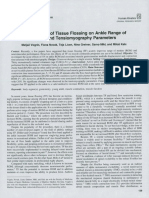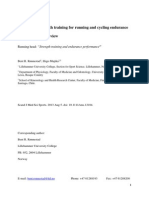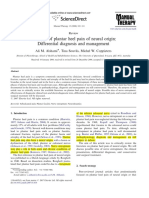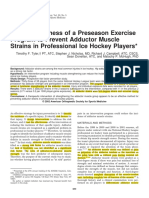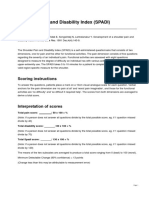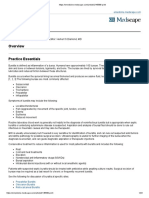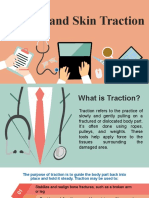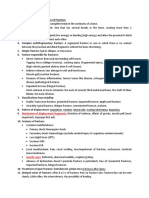Lesson 4 Notes
Lesson 4 Notes
Uploaded by
Oscar NgCopyright:
Available Formats
Lesson 4 Notes
Lesson 4 Notes
Uploaded by
Oscar NgOriginal Title
Copyright
Available Formats
Share this document
Did you find this document useful?
Is this content inappropriate?
Copyright:
Available Formats
Lesson 4 Notes
Lesson 4 Notes
Uploaded by
Oscar NgCopyright:
Available Formats
DrAlisonGrimaldi
Dynamic Stabilisation of the Hip & Pelvis Lesson 4
Topics for Discussion
Normal function
Gluteus maximus & joint pathology
Lesson 4
Gluteus Maximus: Gluteus maximus & unloading
Function & Dysfunction
Implications for therapeutic exercise
Dr Alison Grimaldi PhD, MPhtySt(Sports), BPhty
1
PhysioTec www.physiotec.com.au
www.DrAlisonGrimaldi.com
01
Picture © Primal Pictures Ltd
i2
Normal function
ald Glut Max EMG in gait
Adapted from Stern, Pare & Schwarz 1980
Upper Glut Max:
im
Heel Strike STANCE SWING
1° Abductor function UGM
WALK
Also ER
LGM
Gr
UGM
Lower Glut Max: JOG
1° Extensor function LGM
Also Add & ER Picture © Primal Pictures Ltd UGM
RUN
ni
LGM
so
Ali
Glut max in other WB function Topics for Discussion
Lower glut max will be maximally recruited in a lunge in the Normal function
Dr
trunk forward position (Farrokhi et al 2008)
Gluteus maximus & joint pathology
Always consider gravitational loading in therapeutic exercise
prescription Gluteus maximus & unloading
Implications for therapeutic exercise
Picture © Primal Pictures Ltd
© DrAlisoniGrimaldi 2011 DrAlisonGrimaldi.com page 1
DrAlisonGrimaldi
Dynamic Stabilisation of the Hip & Pelvis Lesson 4
Hip Extensor Strength & OA Glut Max Size & Hip OA
Rasch et al 2007: Associated with loss of strength, loss of muscle size has
19% less isometric hip extensor strength on the side of pathology been demonstrated in GM in those with hip OA
in patients with unilateral OA Rasch et al 2007:
13% smaller in GMax CSA on the side of pathology in
Arokoski et al 2002: patients with unilateral OA
22% less isometric extensor strength & Arokoski et al 2002:
13-14% less isokinetic extensor strength on the side with worst 9% smaller lower GMax CSA on side of worse pathology in
hip OA subjects with hip OA
1
Grimaldi et al 2009:
Use it or lose it! Antalgic unloading will ultimately result in
Measured muscle volume of UGM and LGM separately in
01
reduced strength in antigravity extensors, but could this loss
have preceded the OA? subjects with unilateral hip OA – mild or advanced, and
age & sex matched controls
i2
Mild unilateral hip OA
ald Advanced unilateral hip OA
ANTERIOR ANTERIOR
im
ANTERIOR ANTERIOR
Gr
Affected Side Affected Side
Affected Side Affected Side UGM TFL & LGM
UGM TFL & LGM UGM & LGM: Significantly smaller on affected side (p=0.00;p< 0.05)
UGM significantly larger (mean 24.6%) on unaffected side compared
Differences between sides were not great enough to reach
statistical significance but changes in size and quality observable with normal control subjects (p<0.05). TFL NSD in size
ni
Grimaldi et al 2009
Grimaldi et al 2009
so
Ali
Implications Glut Max Fibre Type & Hip OA
LGM demonstrates atrophy, more evident in advanced Selective loss of fast twitch fibres in gluteus maximus has
Dr
stages of pathology been demonstrated in patients with hip OA
(Sirca & Susec Micheli, 1980)
UGM, like TFL does NOT readily atrophy in the presence of
degenerative hip pathology
UGM & LGM should be considered functionally separate Implications:
muscles & may require differing approaches in targeted Poorer capacity for strength development & shock
management of muscle dysfunction. absorption - increased joint forces
UGM is more functionally similar to TFL. Excessive bulk and Potential to shift towards more tonic function
activity in the upper portion of the gluteus maximus may
not be healthy for the underlying joint. Assess & target Important to address fast twitch fibre function & to ensure
UGM & LGM as 2 separate muscles. avoidance of excessive tonic activation strategies for GM in
functional retraining & therapeutic exercise
© DrAlisoniGrimaldi 2011 DrAlisonGrimaldi.com page 2
DrAlisonGrimaldi
Dynamic Stabilisation of the Hip & Pelvis Lesson 4
Hip extensor exercise & joint forces Topics for Discussion
Lewis et al 2009 Normal function
Measured joint forces in a simulated biomechanical Gluteus maximus & joint pathology
modelling study. Looked at ranges between 10° flexion
and 20° extension in a prone hip extension model. Gluteus maximus & unloading
Highest hip joint forces (*ant), occur in hip extension esp if Implications for therapeutic exercise
gluts are weak.
1
01
Picture © Primal Pictures Ltd
i2
Unloading: Insights for Aetiology?
ald Berlin Bed Rest Study
Muscle deficits in OA – chicken or the egg? Young healthy males restricted to bed for
im
Muscle deficits have been linked to the development and
8 weeks
progression of OA at the knee (Slemender et al 1998, Hurley 1999) MRI’s were taken at baseline, every 2
and hip (Hootman et al 2004) weeks during bed rest, & 5 times during
the ambulant recovery period – 180
Lack of appropriate loading of the musculoskeletal system is days
Gr
thought to be one of the factors leading to the development of
muscle deficits (Richardson 2004) Countermeasure group performed
exercises in bed on a bed mounted
Microgravity research provides the opportunity to observe whole body vibration platform
patterns of muscle change during unloading in healthy subjects
- squats
Unloading studies have shown preferential atrophy of antigravity
muscles, slow twitch muscle fibres, and intrinsic stabilisers at - jumps
the Lx & knee (Fitts et al 2000, Hides et al 2007, Musacchia 1992) - heel raises Straps provided 1.8 x BW
ni
axial compression onto the
- toe raises plate
so
Ali
GMax/TFL during BR & recovery Implications
LGM & UGM demonstrated differing patterns of response to
Dr
unloading
15
While LGM was significantly affected by unloading
Percentage change in average cross-sectional area
10 (7.3%± 7.2% atrophy by 8 weeks), the UGM was not, like
5
the other superficial hip abductor TFL
0
* ** UGM This reflects the patterns seen in the presence of
* LGM degenerative joint pathology and implies that it is possible
-5 TFL
that loss of hip extensor bulk may precede and contribute
-10 to the development of hip OA.
**
-15
BR001 BR014 BR028 BR042 BR056 R014 RO28 RO90 R180
© DrAlisoniGrimaldi 2011 DrAlisonGrimaldi.com page 3
DrAlisonGrimaldi
Dynamic Stabilisation of the Hip & Pelvis Lesson 4
Topics for Discussion Implication for Therapeutic Exercise
Normal function Considering:
Gluteus maximus & joint pathology 1. LGM is an antigravity extensor, negatively impacted upon
by unloading &
Gluteus maximus & unloading 2. Joint forces (*Ant) are increased in hip extension,
Implications for therapeutic exercise particularly if gluteals are weak (Lewis et al 2009), leading
these authors to state that hip extension past neutral is
not recommended for patients with hip OA to limit
compressive loading across joint
1
Which exercises will be most functionally consistent for this
01
muscle, and safest for the underlying joint?
Picture © Primal Pictures Ltd
i2
Therapeutic Exercise for Lower Glut Max
ald Use gravity to your advantage
im
?
Gr
?
ni
so
Ali
Use gravity to your advantage GMax in gait & posture
Considering:
Dr
1. GM is not tonically active during quiet standing or gait &
2. GM experiences a selective loss of fast twitch fibres in hip OA,
therefore a shift towards a slower phenotype
Cues given for posture & gait should be consistent with the
natural function of this muscle
- GM should not be held tight during quiet bilateral standing
- GM should be phasically active during gait- to prepare for and
absorb ground reaction forces at heel strike, and additionally in
TWS Slider, PhysioTec running to rapidly extend the hip to bring the foot back to the
ground.
© DrAlisoniGrimaldi 2011 DrAlisonGrimaldi.com page 4
You might also like
- Nancy Hamilton, Wendi Weimar, Kathryn Luttgens - Kinesiology - Scientific Basis of Human Motion-McGraw-Hill Education (2011)Document640 pagesNancy Hamilton, Wendi Weimar, Kathryn Luttgens - Kinesiology - Scientific Basis of Human Motion-McGraw-Hill Education (2011)Rodrigo100% (1)
- Groin Strain Rehabilitation PDFDocument3 pagesGroin Strain Rehabilitation PDFOscar NgNo ratings yet
- The Painful Shoulder Course Overview (English)Document2 pagesThe Painful Shoulder Course Overview (English)nsboyadzhievNo ratings yet
- Grimaldi 2014 - Manual - Understanding Tendinopathies of The Hip & PelvisDocument51 pagesGrimaldi 2014 - Manual - Understanding Tendinopathies of The Hip & PelvisOscar NgNo ratings yet
- The Asymmetric Pelvis: Liz Gaggini, M.ADocument7 pagesThe Asymmetric Pelvis: Liz Gaggini, M.Aleo100% (2)
- MCQ Biomechanics of Hip JointDocument16 pagesMCQ Biomechanics of Hip Jointdrng48100% (11)
- The Effectiveness of Gait Retraining On Running Kinematics, Kinetics, Performance, Pain, and Injury in Distance Runners A Systematic Review With Meta-AnalysisDocument21 pagesThe Effectiveness of Gait Retraining On Running Kinematics, Kinetics, Performance, Pain, and Injury in Distance Runners A Systematic Review With Meta-AnalysisArmando NetoNo ratings yet
- The Serape Effect: A Kinesiological Model For Core Training: Sport-Specific Condition Sport-Specific ConditioningDocument2 pagesThe Serape Effect: A Kinesiological Model For Core Training: Sport-Specific Condition Sport-Specific Conditioningok okNo ratings yet
- From Modul To Module - Rasmus ÖlmeDocument249 pagesFrom Modul To Module - Rasmus ÖlmeBianca MendonçaNo ratings yet
- Acute Effects of Tissue Flossing On Ankle Range of Motion and Tensiomyography Parameter - Matjaz Vogrin 2021Document8 pagesAcute Effects of Tissue Flossing On Ankle Range of Motion and Tensiomyography Parameter - Matjaz Vogrin 2021YngaMarquezJairNo ratings yet
- Evidence Based Concepts For Prevention of Knee and ACL Injuries. 2017 Guidelines of The Ligament Committee of The German Knee Society (DKG)Document11 pagesEvidence Based Concepts For Prevention of Knee and ACL Injuries. 2017 Guidelines of The Ligament Committee of The German Knee Society (DKG)lipemagalhaesNo ratings yet
- Building The Soldier AthleteDocument82 pagesBuilding The Soldier AthleteDKGIBSONNo ratings yet
- 5K Training Program For BeginnersDocument6 pages5K Training Program For BeginnersAsbel Morales100% (1)
- Opleidingen Voor Personal Trainers - Deel 1 OVERLOAD WORLDWIDEDocument27 pagesOpleidingen Voor Personal Trainers - Deel 1 OVERLOAD WORLDWIDEOverload WorldwideNo ratings yet
- Hip and Groin Pain Radiological AssessmentDocument13 pagesHip and Groin Pain Radiological AssessmentOscar NgNo ratings yet
- Anatomy VivaDocument5 pagesAnatomy VivaAhmedNo ratings yet
- MCQ Biomechanics of Hip Joint 2Document15 pagesMCQ Biomechanics of Hip Joint 2Abdul Musawer0% (1)
- Alison Grimaldi - Back in Motion Presentation - 2014 - Handout 3 Slides PPDocument22 pagesAlison Grimaldi - Back in Motion Presentation - 2014 - Handout 3 Slides PPmajd.rezkallahNo ratings yet
- Myths of The SIJ 2006Document14 pagesMyths of The SIJ 2006César Alejandro Martínez RetamalNo ratings yet
- Strong Traps StarrDocument7 pagesStrong Traps StarrMark KonenNo ratings yet
- Become EQUIPT To Be Your Best in All Aspects of LifeDocument4 pagesBecome EQUIPT To Be Your Best in All Aspects of Lifeapi-297946110No ratings yet
- TMJ Manual 792Document19 pagesTMJ Manual 792Ellery FarrellNo ratings yet
- Mike ReinoldDocument20 pagesMike ReinoldVikas Kashnia0% (1)
- Windows of Opportunity, Optimal Trainability: Long-Term Athlete Development: Trainability in Childhood and AdolescenceDocument8 pagesWindows of Opportunity, Optimal Trainability: Long-Term Athlete Development: Trainability in Childhood and AdolescenceJoe GreenNo ratings yet
- Treatment of Osteitis Pubis Via The Pelvic Muscles PDFDocument4 pagesTreatment of Osteitis Pubis Via The Pelvic Muscles PDFHapplo82No ratings yet
- Natural Alignment: Pelvic Girdle Tilt and ShiftDocument11 pagesNatural Alignment: Pelvic Girdle Tilt and ShiftleoNo ratings yet
- Thor 3 ProgramDocument4 pagesThor 3 ProgramkennerorrerNo ratings yet
- Effectiveness of Direct Vs Indirect Technique Myofascial Release in The Management of Tensiontype HeadacheDocument5 pagesEffectiveness of Direct Vs Indirect Technique Myofascial Release in The Management of Tensiontype Headachekapturzak100% (1)
- Active Recovery PlanDocument4 pagesActive Recovery PlanIwatobiNo ratings yet
- Plantar FacitisDocument20 pagesPlantar FacitisMarifatul HusnaNo ratings yet
- Back ExerciseDocument249 pagesBack ExerciseSamehAlyNo ratings yet
- Review of Dr. Mark Cheng's "Prehab-Rehab 101" SeriesDocument6 pagesReview of Dr. Mark Cheng's "Prehab-Rehab 101" SeriesWilliam TortorielloNo ratings yet
- 1995 Spinal Stabilisation, 2. Limiting Factors To End-Range Motion in The Lumbar SpineDocument9 pages1995 Spinal Stabilisation, 2. Limiting Factors To End-Range Motion in The Lumbar SpineAni Fran SolarNo ratings yet
- Isometric Strength and Its Relationship To Dynamic Performance A Systematic ReviewDocument10 pagesIsometric Strength and Its Relationship To Dynamic Performance A Systematic Reviewlinoco1No ratings yet
- JTG IndexDocument10 pagesJTG IndextesfamichaelNo ratings yet
- Danto AAO Convocation2012LectureDocument48 pagesDanto AAO Convocation2012Lecturercastello20No ratings yet
- Tendon Neuroplastic TrainingDocument9 pagesTendon Neuroplastic TrainingLara VitorNo ratings yet
- Beginner & Advanced Rotator Cuff Exercises For Shoulder Pain - MyodetoxDocument18 pagesBeginner & Advanced Rotator Cuff Exercises For Shoulder Pain - MyodetoxJustin Wigon100% (1)
- Rehabilitation Will Increase The Capacity of Your Insert Musculoskeletal Tissue Here Defining Tissue Capacity A Core Concept For CliniciansDocument3 pagesRehabilitation Will Increase The Capacity of Your Insert Musculoskeletal Tissue Here Defining Tissue Capacity A Core Concept For CliniciansChristhoper HermosillaNo ratings yet
- Cervical AnatomyDocument41 pagesCervical AnatomythwisemanNo ratings yet
- Strength Training and Endurance Performance - ResearchGateDocument27 pagesStrength Training and Endurance Performance - ResearchGateCristianLopezNo ratings yet
- Effect of Knee Position On Hip and Knee Torques During The Barbell SquatDocument5 pagesEffect of Knee Position On Hip and Knee Torques During The Barbell SquatMattNo ratings yet
- StabilityDocument9 pagesStabilityDany Salvatierra AtenasNo ratings yet
- Efficacy of Sot in FemalesDocument7 pagesEfficacy of Sot in FemalesDenise MathreNo ratings yet
- Cristhian Thibaudeau Black Book of Training SecretsDocument222 pagesCristhian Thibaudeau Black Book of Training Secretsaris1968No ratings yet
- Biomechanics 222Document57 pagesBiomechanics 222sjanormanNo ratings yet
- Structural Story HiresDocument4 pagesStructural Story Hiresbradley_6662657No ratings yet
- ChiRunning NotesDocument3 pagesChiRunning Notesbobnotrob100% (1)
- 12 Min Cooper TestDocument4 pages12 Min Cooper Testeeumchem100% (1)
- Costa Rica GlucoseDocument91 pagesCosta Rica GlucoseAnthony HarderNo ratings yet
- Exercise Therapy AssignmentDocument4 pagesExercise Therapy AssignmentApoorv100% (1)
- 4) Lumbar Spinous Push Technique (Type IV), Iliomamillary PushDocument3 pages4) Lumbar Spinous Push Technique (Type IV), Iliomamillary PushNoorAkNo ratings yet
- How Could Periodization Help Enhance MuscleDocument9 pagesHow Could Periodization Help Enhance Musclemehrdad_44No ratings yet
- 20cc-60668367-Postural Restoration Application For Strength and Conditioning Coaches-2Document47 pages20cc-60668367-Postural Restoration Application For Strength and Conditioning Coaches-2wenqihitNo ratings yet
- Hip Pain Dry Needling Versus Cortisone InjectionsDocument1 pageHip Pain Dry Needling Versus Cortisone InjectionsNicolás Ayelef ParraguezNo ratings yet
- Fascial StrechDocument26 pagesFascial StrechDenislav SpasovNo ratings yet
- Constraint Induced Movement TherapyDocument21 pagesConstraint Induced Movement TherapyArslan AslamNo ratings yet
- Biofeedback Stabilizer Manual PDFDocument188 pagesBiofeedback Stabilizer Manual PDFEugenio López Recio100% (1)
- Implementing A Mechanical Model For Plyometric Progressions: Mike Young, PHD Mikeyoungphd MikeyoungDocument75 pagesImplementing A Mechanical Model For Plyometric Progressions: Mike Young, PHD Mikeyoungphd MikeyoungAlpesh JadhavNo ratings yet
- Candito 6 Week Program 1Document21 pagesCandito 6 Week Program 1Mahjoub MahjoubNo ratings yet
- Baumann. 1998. The Snatch Technique of World Class Weightlifters at The 1985 World Championships.Document22 pagesBaumann. 1998. The Snatch Technique of World Class Weightlifters at The 1985 World Championships.César Javier Adrianzén TelloNo ratings yet
- Mendiguchia 2012 Rectus Femoris Muscle Injuries in Football-A Clinically Relevant Review of Mechanisms of Injury, Risk Factors and Preventive Strategies PDFDocument11 pagesMendiguchia 2012 Rectus Femoris Muscle Injuries in Football-A Clinically Relevant Review of Mechanisms of Injury, Risk Factors and Preventive Strategies PDFJuan PalomoNo ratings yet
- Stage 4 - Forced Adaptation: The Quick Guide to Professional Level LiftingFrom EverandStage 4 - Forced Adaptation: The Quick Guide to Professional Level LiftingNo ratings yet
- The Gross Anatomy Study Strategy Volume I: Bone & Muscle (Part 1): The Gross Anatomy Study Strategy, #1.1From EverandThe Gross Anatomy Study Strategy Volume I: Bone & Muscle (Part 1): The Gross Anatomy Study Strategy, #1.1No ratings yet
- Fat PadDocument3 pagesFat PadOscar NgNo ratings yet
- Lumbar ExerciseDocument9 pagesLumbar ExerciseOscar NgNo ratings yet
- Shoulder Pain and Disability Index (Spadi) PDFDocument2 pagesShoulder Pain and Disability Index (Spadi) PDFOscar NgNo ratings yet
- Hamstring RehabilitationDocument29 pagesHamstring RehabilitationOscar NgNo ratings yet
- The Myth of StretchingDocument34 pagesThe Myth of StretchingOscar NgNo ratings yet
- Plantar FasciiliatisDocument9 pagesPlantar FasciiliatisOscar NgNo ratings yet
- The Myth of StretchingDocument34 pagesThe Myth of StretchingOscar NgNo ratings yet
- Non Articular Source of Groin PainDocument41 pagesNon Articular Source of Groin PainOscar NgNo ratings yet
- Hip Adductor RehabilitationDocument4 pagesHip Adductor RehabilitationOscar NgNo ratings yet
- Shoulder TrainingDocument12 pagesShoulder TrainingOscar NgNo ratings yet
- Shoulder Pain and Disability Index (Spadi) PDFDocument2 pagesShoulder Pain and Disability Index (Spadi) PDFOscar NgNo ratings yet
- InflammationDocument13 pagesInflammationOscar NgNo ratings yet
- Facet Joints: Part of "CHAPTER 75 - General Considerations of Pain in The Low Back, Hips, and LowerDocument5 pagesFacet Joints: Part of "CHAPTER 75 - General Considerations of Pain in The Low Back, Hips, and LowerOscar NgNo ratings yet
- ABK Strengthening ExercisesDocument4 pagesABK Strengthening ExercisesStephanie JacksonNo ratings yet
- Frenkel'S Exercises: Reviewed by Yose RizalDocument24 pagesFrenkel'S Exercises: Reviewed by Yose Rizalmilenia w. shandra100% (1)
- Superficial Femoral Artery InjuryDocument3 pagesSuperficial Femoral Artery InjuryErlin EsauNo ratings yet
- GSC - DDH LCPD SCFE and OthersDocument3 pagesGSC - DDH LCPD SCFE and OthersJulia SalvioNo ratings yet
- Fetto - 2019 - A Dynamic Model of Hip Joint Biomechanics The Contribution of Soft TissuesDocument8 pagesFetto - 2019 - A Dynamic Model of Hip Joint Biomechanics The Contribution of Soft TissuesAdrianNo ratings yet
- BursitisDocument23 pagesBursitisAngie Paola RodriguezNo ratings yet
- Casts. Braces. TractionDocument3 pagesCasts. Braces. TractionClancy Anne Garcia Naval100% (1)
- Skeletal and Skin TractionDocument16 pagesSkeletal and Skin TractionJam Corros100% (2)
- Femur Fractures in Children - Case PresentationDocument22 pagesFemur Fractures in Children - Case PresentationChristian Micallef100% (1)
- Trauma Vivas for the FRCS : a Case-Based Approach First Edition Anakwe download pdfDocument52 pagesTrauma Vivas for the FRCS : a Case-Based Approach First Edition Anakwe download pdfzinnurqitaj100% (2)
- 2011 Cook Purdam Is Compressive Load A Factor in The DevelopmentDocument6 pages2011 Cook Purdam Is Compressive Load A Factor in The DevelopmentHerlon Habib VitaNo ratings yet
- Ortho EssentialsDocument8 pagesOrtho EssentialsShoban RajNo ratings yet
- Review - SurgeryDocument40 pagesReview - SurgerymedstudNo ratings yet
- ASTM D4910D4910M-08 (Reapproved 2013)Document6 pagesASTM D4910D4910M-08 (Reapproved 2013)Sandra LopesNo ratings yet
- Hips Pelvis PR PDFDocument19 pagesHips Pelvis PR PDFluulaaNo ratings yet
- Deadly Pressure PointsDocument7 pagesDeadly Pressure PointsNano Zeta100% (1)
- GaitDocument7 pagesGaitKatrina KinaNo ratings yet
- Supple Leopard Mobility NotesDocument4 pagesSupple Leopard Mobility Notesbtwx67% (3)
- 4 Basic Element For Normal MovementDocument17 pages4 Basic Element For Normal MovementKwai Fong ChanNo ratings yet
- Catatan Orthopedi AriefDocument8 pagesCatatan Orthopedi Ariefmiwer 765No ratings yet
- 6 571 pp83 102 PDFDocument21 pages6 571 pp83 102 PDFdini aviantiNo ratings yet
- Download ebooks file Essentials of musculoskeletal care Fifth Edition American Academy Of Orthopaedic Surgeons. all chaptersDocument65 pagesDownload ebooks file Essentials of musculoskeletal care Fifth Edition American Academy Of Orthopaedic Surgeons. all chapterspaceyzurlog4100% (1)
- A Systematic Approach To The Hip-Spine Relationship and Its Applications To Total Hip Arthroplasty - Eftekhary Et Al. 2019Document9 pagesA Systematic Approach To The Hip-Spine Relationship and Its Applications To Total Hip Arthroplasty - Eftekhary Et Al. 2019Mohammad KaramNo ratings yet
- Hip JointDocument25 pagesHip JointHashim OmarNo ratings yet
- Npte Practice Paper No # 04Document47 pagesNpte Practice Paper No # 04Ismail JamilNo ratings yet









